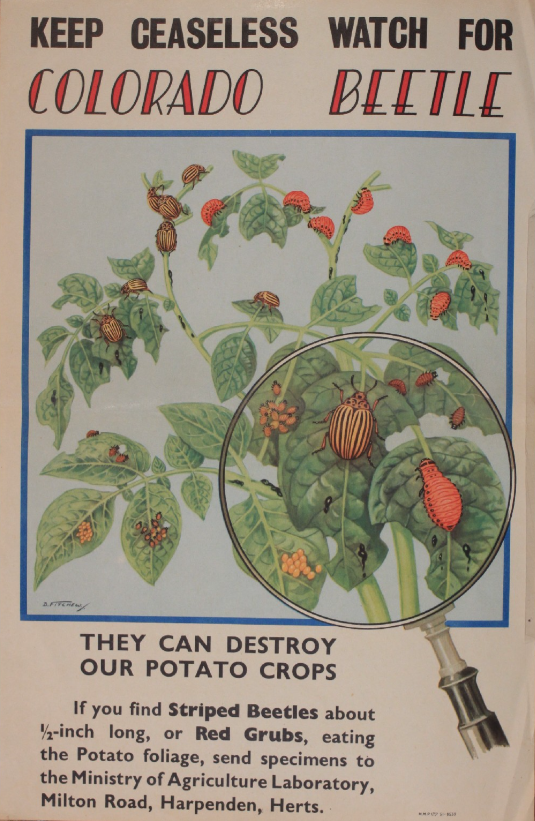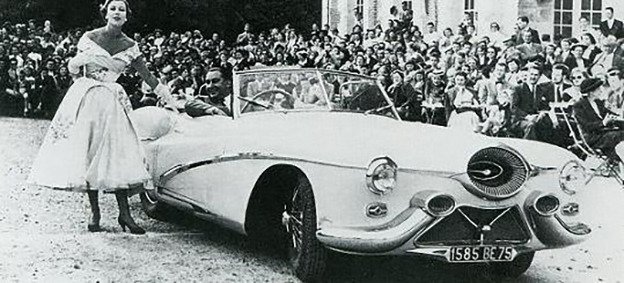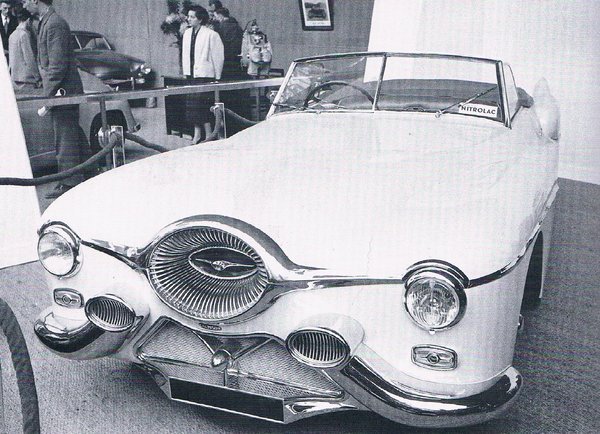This week we are repeating some Notes from the Sticks columns. This was first published on May 21, 2023.
BEFORE Covid, before even the spectre of nuclear war, there were posters in every public building warning about another dire threat to the British way of life. It was less than half an inch long, with a yellow/orange body and ten brown stripes: the dreaded Colorado beetle.
Here is a poster which I remember well from the 1950s.

I can’t have understood much about magnification at that time, because I thought the beetles were about a foot long, and I longed to find one.
The Colorado beetle (Leptinotarsa decemlineata) is native to the area between Colorado and northern Mexico, and was discovered in 1824 by Thomas Say in the Rocky Mountains. It is partial to the leaves of various plants in the solanum family, of which the potato is a member, so when farmers started cultivating potatoes in America it must have been like manna from heaven. It first destroyed potato crops in the region of Omaha, Nebraska in 1859 and spread eastward at an average distance of 87 miles a year. (Although it eats the leaves, not the underground tubers, if the plant is stripped of its leaves before the tubers form, the crop is lost.) By 1874 it had reached the Atlantic Coast, and despite warnings from American entomologists it soon made it to Europe. From 1875, Germany, Belgium, France and Switzerland banned imports of American potatoes but the beetle was unstoppable and was recorded at Liverpool docks in 1877.
As far as I can tell the first attempts at control were no more than picking the beetles off by hand, but the development of insecticides heralded the start of a running battle which continues to this day. So far the beetle has developed resistance to 56 different chemicals. Some bacterial controls have been reasonably successful but the main defence is rotation of crops.
The beetle has been eradicated in the UK at least 163 times but for a long time it kept coming back. However the last major outbreak was in 1976, so today’s children have probably never heard of it. I have to admit to a sneaking regard for its persistence, but then I am not a potato farmer.
***
Sheep of the Week

Last week I wrote about the Border Leicester, the largest indigenous breed in the British Isles. As I said, It is derived from the Leicester Longwool, which was developed by the great Robert Bakewell of Dishley in Leicestershire in the 18th century (I wrote about the breed here). Two of his students, George and Mathew Culley, took some Leicester Longwools to the Glendale district of Northumberland, where they settled around 1767, and by crossing them with other breeds including Teeswaters, they developed the Border Leicester. At the end of the 19th century, breeders started to select dark-skinned Border Leicesters with fine fleeces. Blue-skinned Wensleydales (which I wrote about here) were also probably used. The result was the Bluefaced Leicester.
This is a distinctive sheep, with blue skin on the face and neck and a pronounced roman nose.
After Notes from the Sticks was published last week, reader ‘peasantfarmer’ got in touch. He farms in the North East, and he very kindly wrote this for me:
‘I bought two Bluefaced Leicester ewes last year including a coloured (brown fleeced) one to go with the Teeswaters I have. They weigh up to 110 kg, which is large. Here they are:

‘The breed is the sire of cross-bred mule sheep which are the most numerous sheep in the country. The Bluefaced Leicester is bred with Swaledale ewes to produce the North of England mule, Welsh mountain ewes to produce the Welsh mule and bred with Scottish blackface sheep to produce the Scottish mules. These mule sheep are the basis of most commercial flocks which use the mule ewe crossed with a terminal sire to produce lean lambs for the butcher.
‘As the BFL rams are used as a sire for hardy hill sheep they are usually kept inside during the winter as they are less able to withstand the harshness of winters on hill farms.
‘When entered for shows the wool on the neck and face are trimmed very short so the coloured skin underneath will show through to emphasise the ‘blueness’ [see the picture at the top]. Their long neck, roman nose and large size leads to visitors who are not familiar with BFLs thinking they are some relation to llamas.
‘The fleece is amongst the finest from native breeds with a thin (26-26.5 micron) width, an inbuilt lustre and silkiness with a length of 8-15 cm making it ideal as a luxury knitting wool for garments. There is not a great deal of wool on a fleece (1-2 kg) but it commands a much higher price on the wool market.
‘Speculation on my part is that the BFL as a terminal sire is now being replaced by Texel and Beltex sheep as totally lean lamb is the meat required by supermarkets. Teeswaters are now starting to be kept for their wool and maybe the BFL will go the same way.

‘My coloured BFL, above, is a rarity, which seems to have transposed coloured wool. Where there would be white wool there is coloured wool and white wool on the face where there would be coloured wool. The fleece from this one will be kept for producing unique sets of woollen hats and gloves for family.’
Thanks very much, peasantfarmer.
Here is a video of some BFLs, followed by mule (cross-bred) ewes.
You can read more at the Bluefaced Leicester Sheep Breeders’ Association website.
***
Wheels of the week
TCW’s wonderful friend in Florida, Audre Myers, sent me pictures of this amazing motor.




It is a Salmson S4E convertible designed by coachbuilder Henri Esclassan of Boulogne. This is the only one that was built, for the 1953 Paris Motor Show.
I can’t find out a lot about this model. The only note I have seen says that it was ‘an attempt to evoke the LeSabre from GM/Harley Earl’. This was another gorgeous machine which you can see here. As the legend says, it was influenced by the design of jet fighter planes.
The Salmson brand was established by Émile Salmson in Paris in 1890, making steam-powered compressors and centrifugal pumps for railway and military purposes, moving on to petrol-powered lifts and motors.
It was one of the first firms to make aircraft engines, and during World War I made complete aeroplanes, mainly the two-seat fighter/reconnaissance plane, the Salmson 2A2, used in combat by both the French and the American Expeditionary force.
After World War I the company started making car bodies and then complete cars. It continued making aircraft engines through World War II, and cars thereafter. The firm went bankrupt in in 1953 and all activities ceased in 1957.











